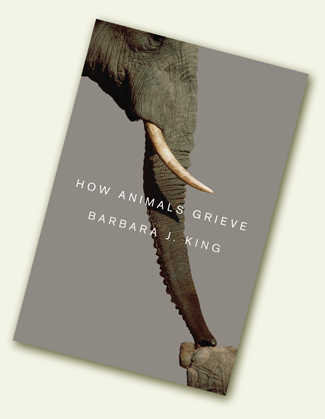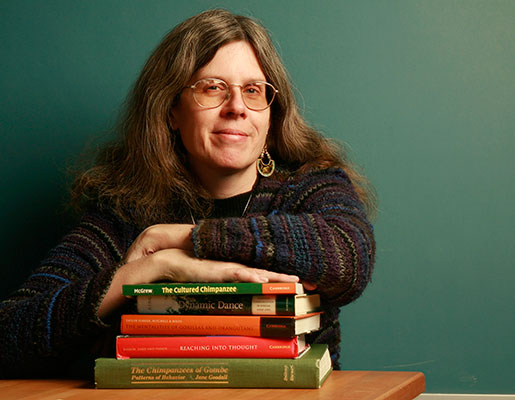Animal grief
Barbara King’s book shows animals grieve ... and it's because they love
Animals feel grief; they mourn. And there are enough documented examples of the phenomenon to fill a book.
Barbara J. King wrote that book, How Animals Grieve, a multi-species examination of loss, love and mourning that challenges prevailing notions that grief is an emotion experienced only by humans, and modern humans, at that.
Animal grief is a contentious and mystifying phenomenon and one that generates a great deal of public interest. King’s book is the centerpiece of the story “The Mystery of Animal Grief” in the April 5 issue of Time.
 How Animals Grieve,
published by the University of Chicago Press, delivers many examples of
mourning behavior among apes, cetaceans and other large-brained mammals, but it
also contains accounts of keening cats, devoted ducks and depressed bunnies.
There’s even a sea turtle that crawls out of the ocean to join a group of
humans holding an observance for a turtle named Honey Girl, a favorite on
Oahu’s Turtle Beach.
How Animals Grieve,
published by the University of Chicago Press, delivers many examples of
mourning behavior among apes, cetaceans and other large-brained mammals, but it
also contains accounts of keening cats, devoted ducks and depressed bunnies.
There’s even a sea turtle that crawls out of the ocean to join a group of
humans holding an observance for a turtle named Honey Girl, a favorite on
Oahu’s Turtle Beach.
Animals grieve, but not always
King, Chancellor Professor of Anthropology at William & Mary, says that despite the variety and sheer number of anecdotal reports, when it comes to grieving behavior, animals don’t display it consistently. She has written about animal grief in earlier books and articles and particularly in the slot on 13.7, the National Public Radio science blog, where discussion of grief-stricken house pets alarmed more than one reader.
“I had someone e-mail me and say ‘My dog isn’t grieving!,” King recalled. “There’s a dead dog in my house and my other dog isn’t grieving! What’s wrong with my dog?’”
The long and the short of it, King explains, is that some dogs mourn the loss of a companion and some don’t. There may even be a reason. In her chapter titled “Dog’s Best Friend,” King relates a story from a web-based discussion concerning a surviving dog’s apparent indifference to the death of an animal the owner referred to as Dog Number One. King points out that the death would allow Dog Number Two to move up a big step on the canine socioeconomic ladder.
“This new status meant that she had more attention, and thus her life improved, a far more important outcome, for her, than the first dog’s death,” she writes.
Animals grieve…but not always
The first chapter of the book deals with the death of Carson, a Siamese cat whose death caused anguish to her sister, Willa, in the home of some of King’s friends. Willa and Carson were, in contemporary human terms, BFF. They had a habit of sleeping on an ottoman cushion together, backbone to backbone, “like the joined wings of a butterfly,” King writes. Willa took Carson’s death badly.
“With a glance at the soft, warm cushion, she lets out a wail,” King writes in the chapter “Keening for Carson the Cat.” “Moving on to the master bedroom, she jumps to the head of the bed and pushes her face and body into a cozy cave-space behind the pillows. She look, and looks; another wail escapes her. It’s sudden and terrible, not a noise one would expect from a cat.”
King has extensive personal experience with housecats; six are co-residents of her Gloucester home. She also is active in feline rescue and spay/neuter campaigns. While she is “utterly convinced” that Willa was grieving for Carson, she has seen no similar mourning behavior in her own feline community. She says it’s possible that her cats have bonded with her and her husband, rather than each other, but acknowledges that the explanation is only one of many possibilities.
“The lesson for me here is that there’s a great deal of context that goes into these individuals and their emotional responses to death,” she explained. “I see this book as means to call more attention to grief.”
More formal study is needed to understand animal emotions
King is a scientist and hopes her book spurs interest in conducting more formal research of the phenomenon of animal emotions.
“When it comes to animal emotion, today’s animal-behavior science tacks back and forth between analysis of events noted by credible observers and evidence derived from controlled experiments,” she writes.
She cites a controlled study of elephants in Kenya, near where King herself spent considerable time studying baboons. A group of elephant researchers knew from field observation and previous studies that elephants frequently would caress the bleached bones of elephants lying on the ground.
Many people—including King—thought that the elephants could distinguish the bones of their dead relatives, but a controlled experiment revealed that though elephants preferred skulls of elephants to those of other animals, there was no evidence that they could detect the bones of their kin. It’s a good example of the need for applying the scientific method to verify or falsify notions that seem to be clear even to the experts.
How Animals Grieve addresses how human grief is distinct from animal grief. For instance, she writes about her visit to a memorial for Holocaust victims in Berlin and reflects on the singular capacity of Homo sapiens to mourn for the loss of individuals we’ve never known.
Is there an adaptive advantage to grief?
King also deals with the nature of grief itself. There are a number of theories about the origin of grief; King explains that one hypothesis holds that grief is a magnification of the separation response common when two animals who have formed a bond—sometimes, but not always, mates—find themselves apart. She explains that the distressed behaviors characteristic of the separation response might represent an adaptive advantage.
“In some cases, a grief reaction may ensure that a partner in a separated pair doesn’t too quickly turn to a new mate, when the missing animal may yet return,” she writes. “In other cases there is no apparent benefit; grief then may just be a natural, highly elaborated by-product of the separation response or, more broadly, of the animal’s close bonds.”
There are evolutionary theories for grief and neurological
depictions of what happens in the brain during times of bereavement. How Animals Grieve deals with these
clinical explanations, but King returns again and again to a simpler
explanation: Animals, including humans, grieve because they have loved. ![]()
















